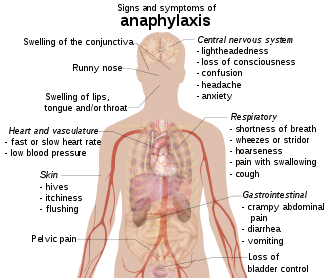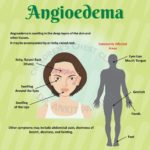Understanding the Life-Threatening Allergic Reaction
Anaphylaxis is a severe, life-threatening allergic reaction that requires immediate medical attention. It can occur in response to certain foods, medications, insect stings, or exposure to environmental allergens. In this article, we will explore the causes, symptoms, diagnosis, treatment, and prevention of anaphylaxis.
What is Anaphylaxis?
Anaphylaxis is a severe, potentially life-threatening allergic reaction that occurs suddenly and affects multiple systems of the body. It can cause breathing difficulties, a drop in blood pressure, and loss of consciousness. Anaphylaxis can be triggered by a variety of allergens, including:
- Foods, such as peanuts, tree nuts, shellfish, milk, and eggs
- Medications, such as antibiotics, nonsteroidal anti-inflammatory drugs (NSAIDs), and contrast dyes used in imaging tests
- Insect stings, such as from bees, wasps, and fire ants
- Latex and other environmental allergens
Causes of Anaphylaxis
Anaphylaxis occurs when the body’s immune system overreacts to an allergen and releases large amounts of histamine and other chemicals. These chemicals cause widespread inflammation and can affect the respiratory, cardiovascular, and gastrointestinal systems. The exact cause of anaphylaxis is not always clear, but risk factors include:
- A history of previous allergic reactions or anaphylaxis
- A family history of allergies or asthma
- Asthma or other respiratory conditions
- Taking certain medications, such as beta-blockers, ACE inhibitors, or aspirin
- Exposure to certain environmental allergens, such as latex
Symptoms of Anaphylaxis
Anaphylaxis can cause a wide range of symptoms that vary in severity and can develop rapidly. The most common symptoms include:
- Hives, itching, and swelling of the skin or mucous membranes
- Flushed or pale skin
- Nausea, vomiting, abdominal pain, and diarrhea
- Tightness in the chest, wheezing, or shortness of breath
- Rapid or weak pulse, low blood pressure, and fainting
Diagnosis of Anaphylaxis
Anaphylaxis is a medical emergency and requires immediate treatment. If you or someone else experiences symptoms of anaphylaxis, seek emergency medical attention right away. A doctor or other healthcare provider can diagnose anaphylaxis based on a physical exam, medical history, and diagnostic tests, such as blood tests, skin tests, or allergy testing.
Treatment of Anaphylaxis
The first line of treatment for anaphylaxis is epinephrine, which is administered via an injection into the thigh. Epinephrine helps to reverse the symptoms of anaphylaxis by constricting blood vessels, relaxing the muscles in the airways, and increasing the heart rate. Other treatments may include:
- Oxygen therapy or mechanical ventilation to help with breathing
- Intravenous fluids or medications to raise blood pressure
- Antihistamines and corticosteroids to reduce inflammation
- Close monitoring in a hospital or intensive care unit
Prevention of Anaphylaxis
There are several steps you can take to reduce the risk of anaphylaxis:
- Avoid allergens that trigger anaphylaxis, such as certain foods, medications, or insect stings.
- Carry an epinephrine auto-injector with you at all times if you have a history of anaphylaxis.
- Wear medical alert jewelry or carry a medical alert card that indicates your allergies.
- Educate yourself and others about anaphylaxis and how to recognize and respond to an allergic reaction.
Conclusion
Anaphylaxis is a serious and potentially life-threatening allergic reaction that requires immediate medical attention. It is important to be aware of the causes, symptoms, diagnosis, treatment, and prevention of anaphylaxis to protect yourself and your loved ones from this dangerous condition.
If you have a history of anaphylaxis or are at risk of an allergic reaction, talk to your healthcare provider about how to manage your allergies and reduce your risk of anaphylaxis. Remember to carry your epinephrine auto-injector with you at all times and seek emergency medical attention if you experience symptoms of anaphylaxis.
By taking steps to prevent anaphylaxis and knowing how to recognize and respond to an allergic reaction, you can protect yourself and others from this potentially life-threatening condition.
FAQs
- What is the difference between anaphylaxis and a mild allergic reaction?
Anaphylaxis is a severe and potentially life-threatening allergic reaction that affects multiple systems of the body, while a mild allergic reaction typically only affects one system, such as the skin or respiratory system. - Can anaphylaxis occur without a previous history of allergies?
Yes, anaphylaxis can occur without a previous history of allergies, although it is more likely to occur in people who have a history of allergies or asthma. - What should I do if I experience symptoms of anaphylaxis?
If you experience symptoms of anaphylaxis, such as difficulty breathing or a rapid pulse, seek emergency medical attention right away. Call 911 or your local emergency number and use your epinephrine auto-injector if you have one. - Can anaphylaxis be prevented?
While anaphylaxis cannot always be prevented, there are steps you can take to reduce your risk of an allergic reaction, such as avoiding known allergens, carrying an epinephrine auto-injector, and wearing medical alert jewelry. - How long does it take for anaphylaxis to occur after exposure to an allergen?
Anaphylaxis can occur within seconds or minutes of exposure to an allergen, although it may take longer in some cases. It is important to seek immediate medical attention if you experience symptoms of anaphylaxis.
DISCLAIMER:
This information is not presented by a medical practitioner and is for educational and informational purposes only. The content is not intended to be a substitute for professional medical advice, diagnosis, or treatment. Always seek the advice of your physician or other qualified healthcare providers with any questions you may have regarding a medical condition. Never disregard professional medical advice or delay in seeking it because of something you have read.
Since natural and/or dietary supplements are not FDA-approved they must be accompanied by a two-part disclaimer on the product label: that the statement has not been evaluated by FDA and that the product is not intended to “diagnose, treat, cure or prevent any disease.”





